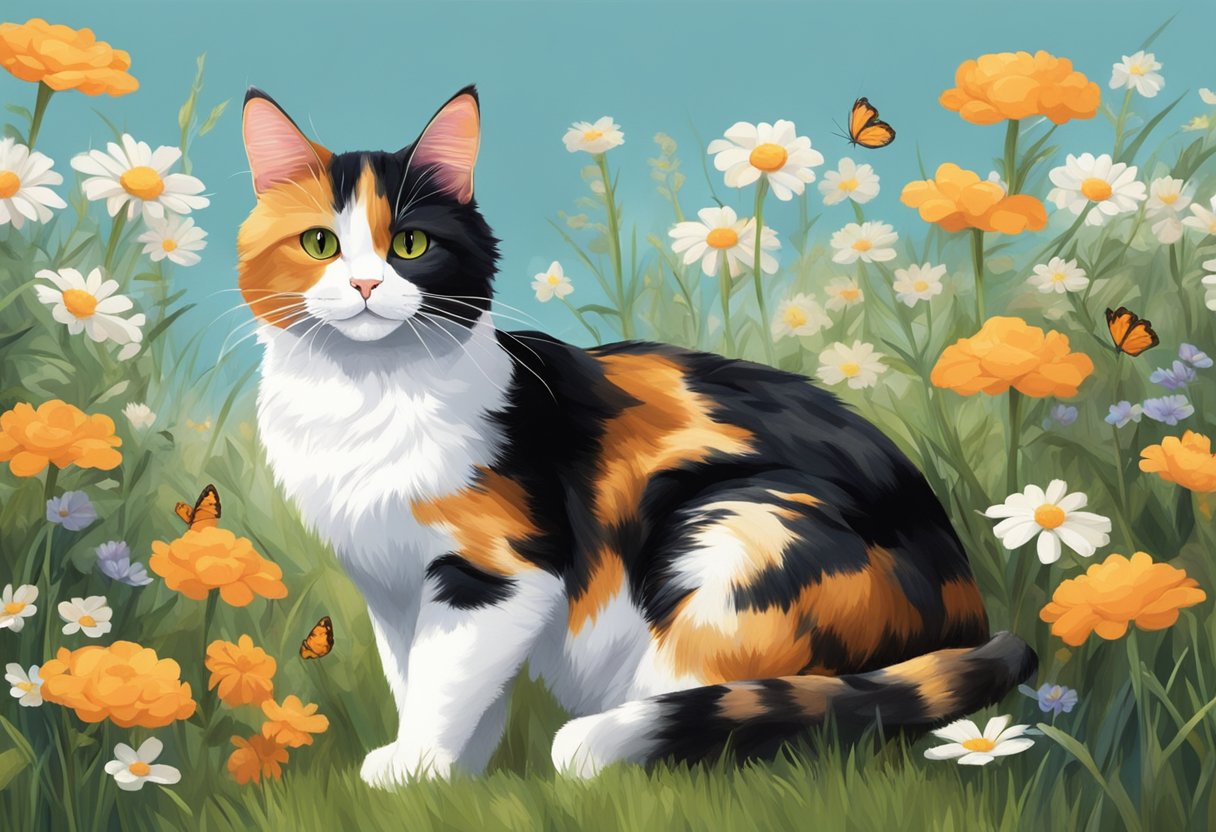Types Of Calico Cats
Calico cats are known for their striking tri-colored coats that feature patches of white, black, and orange or red. These unique felines have captured the hearts of cat lovers around the world with their distinctive patterns and playful personalities. There are several different types of calico cats, each with their own set of genetic traits and breed-specific patterns.
The genetics of calico cats are fascinating and complex. Calico cats are almost always female, as the genes responsible for their unique coloring are linked to the X chromosome. Male calico cats are rare and are typically sterile. The patterns and colors of calico cats are determined by a combination of genes, including the white spotting gene, the tabby gene, and the dilution gene. Understanding the genetics of calico cats can help cat owners better understand their pets and appreciate their unique beauty.
Key Takeaways
- Calico cats are known for their tri-colored coats of white, black, and orange or red.
- There are several different types of calico cats, each with their own set of genetic traits and breed-specific patterns.
- Understanding the genetics of calico cats can help cat owners better understand their pets and appreciate their unique beauty.
Genetics of Calico Cats

Calico cats have a unique coat pattern that results from a combination of genetic factors. Their coat is made up of three colors, white, black, and orange, which are distributed in an irregular pattern. This pattern is not found in any other cat breed and is specific to calico cats.
X Chromosome Influence
The calico coat pattern is determined by the X chromosome. Female calico cats have two X chromosomes, one from each parent, while male calico cats have only one X chromosome. The X chromosome carries the genes that determine coat color, and the calico pattern is the result of a random inactivation of one of the X chromosomes in each cell during embryonic development.
Klinefelter Syndrome in Male Calicos
Male calico cats are rare, and most of them are sterile. This is because they have an extra X chromosome, a condition known as Klinefelter syndrome. This extra X chromosome interferes with the development of male reproductive organs, making them sterile. Male calico cats are usually the result of a genetic mutation or a chromosomal abnormality.
In conclusion, the genetics of calico cats are complex and fascinating. The calico coat pattern is determined by the X chromosome, and female calico cats have two X chromosomes, while male calico cats have one or two X chromosomes. Male calico cats are rare, and most of them are sterile due to Klinefelter syndrome.
Calico Cat Varieties
Calico cats are popular for their unique coat patterns that include a combination of white, black, and orange/red patches. The different variations of calico cats are based on the proportion of white, black, and orange/red patches on their coat.
Traditional Calico
The traditional calico cat is largely white with 25% to 75% black and orange/red markings. This coat pattern does not inherit the dilute gene that causes color dilution. The breed standards that allow for calico coloration include American Shorthair, Turkish Van, Maine Coon, and Japanese Bobtail. Traditional calico cats are known for their friendly and adaptable temperament.
Dilute Calico
The dilute calico cat has a softer coloration than traditional calicos, with a pale grey, blue, or cream base color instead of white. The black patches are replaced with grey or blue, while the orange/red patches are replaced with cream. Dilute calicos inherit the dilute gene that causes color dilution. This gene is responsible for the softer coloration of their coat. The breed standards that allow for dilute calico coloration include American Curl, British Shorthair, and Persian.
Tabby Calico
The tabby calico cat has a unique coat pattern that combines the calico with the tabby pattern. The tabby pattern is characterized by stripes, dots, or swirling patterns on the coat. The patches on the tabby calico cat are usually larger than those on traditional or dilute calicos. The breed standards that allow for tabby calico coloration include American Shorthair, Maine Coon, and Domestic Shorthair.
Calico cats are also known as tortoiseshell or patched tabby calicos. These cats are popular for their unique coat patterns and friendly temperament. The different variations of calico cats offer a wide range of options for cat lovers to choose from.
Breed-Specific Calico Patterns
Calico cats come in a variety of breeds, each with its own unique pattern. In this section, we will explore the calico patterns of three popular domestic cat breeds: American Shorthair, Maine Coon, and Exotic Shorthair.
American Shorthair Calicos
The American Shorthair breed is known for its friendly and easy-going temperament. They are also known for their striking calico patterns, which can include white, black, and orange patches. The black and orange patches are typically tabby-patterned, while the white patches are solid. American Shorthair calicos may also have a muted or dilute coloration, which can give them a softer appearance.
Maine Coon Calicos
Maine Coons are one of the largest domestic cat breeds and are known for their long, fluffy coats. Their calico patterns can be quite striking, with large patches of white, black, and orange. The black and orange patches may be tabby-patterned, while the white patches are solid. Maine Coon calicos may also have a smoke or shaded coloration, which can give them a unique and beautiful appearance.
Exotic Shorthair Calicos
Exotic Shorthairs are a breed of cat that has a similar appearance to the Persian breed, but with shorter hair. Their calico patterns can be quite diverse, with a range of colors and patterns. Exotic Shorthair calicos may have white, black, and orange patches, with the black and orange patches often being tabby-patterned. They may also have a silver or golden coloration, which can give them a luxurious appearance.
Overall, calico cats are a beautiful and unique addition to any family. Whether you prefer the friendly American Shorthair, the fluffy Maine Coon, or the luxurious Exotic Shorthair, there is a calico pattern to suit your tastes.
Behavioral and Personality Traits
Calico cats are known for their unique tri-color coat patterns, but they also have distinct behavioral and personality traits. Understanding these traits can help pet owners provide the best care for their calico cats.
Common Personality Characteristics
Calico cats are known for their sweet, affectionate, and friendly personalities. They are often playful and energetic, enjoying interactive playtime with their owners. Calico cats are also intelligent and loyal, often forming strong bonds with their owners.
However, like any cat, individual personality traits can vary. Some calico cats may be more independent or reserved, while others may be more outgoing and social. It is important for pet owners to spend time with their calico cats and get to know their unique personalities.
Breed Influences on Behavior
While calico cats are not a specific breed, their coat pattern can be found in many different breeds. Breed can influence a cat’s personality and behavior, so it is important for pet owners to research the specific breed of their calico cat.
For example, American Shorthair calico cats are known for their friendly and adaptable personalities, while Persian calico cats may be more reserved and require more grooming. Understanding breed influences can help pet owners provide the best care for their calico cats.
Overall, calico cats have unique and lovable personalities that make them great pets for many families. By understanding their behavioral and personality traits, pet owners can provide the best care for their furry friends.
Calico Cats in Culture and History
Calico cats have a rich history and cultural significance that spans across different regions of the world. In this section, we will explore the symbolism and folklore associated with calico cats, as well as their historical significance.
Symbolism and Folklore
Calico cats have been associated with good luck, particularly in Japan where they are considered to bring prosperity and wealth. In fact, they are often featured in Japanese art and literature, and are sometimes referred to as “maneki neko” or the “beckoning cat” due to the belief that they bring good fortune.
In Egypt, calico cats were also revered and considered to be sacred. They were often depicted in ancient Egyptian art and were believed to have healing powers. In the Mediterranean, calico cats were thought to ward off evil spirits and were often kept as pets.
Historical Significance
Calico cats have played a significant role in the history of Maryland, where they were declared the state cat in 2001. The calico cat was chosen due to its resemblance to the colors of the Baltimore oriole, which is the state bird. In addition, calico cats have been featured in the artwork of Maryland native, Louis Comfort Tiffany.
The name “calico” is believed to have originated from the city of Calicut in southwestern India, where printed calico fabric was first produced. The fabric was later imported into the United States from Lancashire, England, in the 1780s, and a linguistic separation occurred there.
In conclusion, calico cats have a rich cultural and historical significance that spans across different regions of the world. They are associated with good luck, have played a significant role in the history of Maryland, and have a unique etymology that traces back to the production of printed calico fabric.






